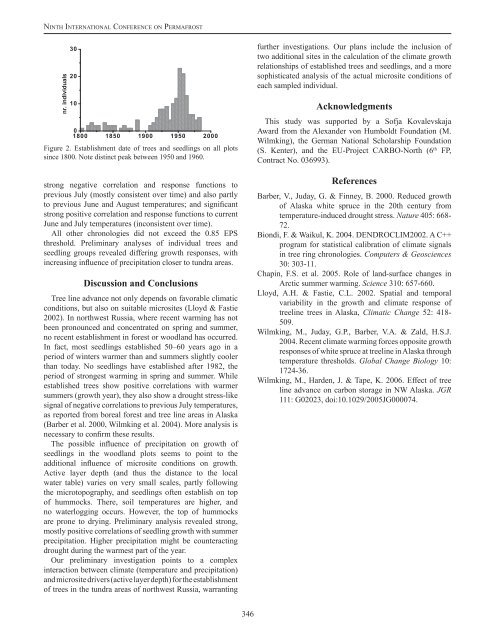Ninth International Conference on Permafrost ... - IARC Research
Ninth International Conference on Permafrost ... - IARC Research
Ninth International Conference on Permafrost ... - IARC Research
You also want an ePaper? Increase the reach of your titles
YUMPU automatically turns print PDFs into web optimized ePapers that Google loves.
Ni n t h In t e r n at i o n a l Co n f e r e n c e o n Pe r m a f r o s tnr. individuals30201001800 1850 1900 1950 2000Figure 2. Establishment date of trees and seedlings <strong>on</strong> all plotssince 1800. Note distinct peak between 1950 and 1960.str<strong>on</strong>g negative correlati<strong>on</strong> and resp<strong>on</strong>se functi<strong>on</strong>s toprevious July (mostly c<strong>on</strong>sistent over time) and also partlyto previous June and August temperatures; and significantstr<strong>on</strong>g positive correlati<strong>on</strong> and resp<strong>on</strong>se functi<strong>on</strong>s to currentJune and July temperatures (inc<strong>on</strong>sistent over time).All other chr<strong>on</strong>ologies did not exceed the 0.85 EPSthreshold. Preliminary analyses of individual trees andseedling groups revealed differing growth resp<strong>on</strong>ses, withincreasing influence of precipitati<strong>on</strong> closer to tundra areas.Discussi<strong>on</strong> and C<strong>on</strong>clusi<strong>on</strong>sTree line advance not <strong>on</strong>ly depends <strong>on</strong> favorable climaticc<strong>on</strong>diti<strong>on</strong>s, but also <strong>on</strong> suitable microsites (Lloyd & Fastie2002). In northwest Russia, where recent warming has notbeen pr<strong>on</strong>ounced and c<strong>on</strong>centrated <strong>on</strong> spring and summer,no recent establishment in forest or woodland has occurred.In fact, most seedlings established 50–60 years ago in aperiod of winters warmer than and summers slightly coolerthan today. No seedlings have established after 1982, theperiod of str<strong>on</strong>gest warming in spring and summer. Whileestablished trees show positive correlati<strong>on</strong>s with warmersummers (growth year), they also show a drought stress-likesignal of negative correlati<strong>on</strong>s to previous July temperatures,as reported from boreal forest and tree line areas in Alaska(Barber et al. 2000, Wilmking et al. 2004). More analysis isnecessary to c<strong>on</strong>firm these results.The possible influence of precipitati<strong>on</strong> <strong>on</strong> growth ofseedlings in the woodland plots seems to point to theadditi<strong>on</strong>al influence of microsite c<strong>on</strong>diti<strong>on</strong>s <strong>on</strong> growth.Active layer depth (and thus the distance to the localwater table) varies <strong>on</strong> very small scales, partly followingthe microtopography, and seedlings often establish <strong>on</strong> topof hummocks. There, soil temperatures are higher, andno waterlogging occurs. However, the top of hummocksare pr<strong>on</strong>e to drying. Preliminary analysis revealed str<strong>on</strong>g,mostly positive correlati<strong>on</strong>s of seedling growth with summerprecipitati<strong>on</strong>. Higher precipitati<strong>on</strong> might be counteractingdrought during the warmest part of the year.Our preliminary investigati<strong>on</strong> points to a complexinteracti<strong>on</strong> between climate (temperature and precipitati<strong>on</strong>)and microsite drivers (active layer depth) for the establishmentof trees in the tundra areas of northwest Russia, warrantingfurther investigati<strong>on</strong>s. Our plans include the inclusi<strong>on</strong> oftwo additi<strong>on</strong>al sites in the calculati<strong>on</strong> of the climate growthrelati<strong>on</strong>ships of established trees and seedlings, and a moresophisticated analysis of the actual microsite c<strong>on</strong>diti<strong>on</strong>s ofeach sampled individual.AcknowledgmentsThis study was supported by a Sofja KovalevskajaAward from the Alexander v<strong>on</strong> Humboldt Foundati<strong>on</strong> (M.Wilmking), the German Nati<strong>on</strong>al Scholarship Foundati<strong>on</strong>(S. Kenter), and the EU-Project CARBO-North (6 th FP,C<strong>on</strong>tract No. 036993).ReferencesBarber, V., Juday, G. & Finney, B. 2000. Reduced growthof Alaska white spruce in the 20th century fromtemperature-induced drought stress. Nature 405: 668-72.Bi<strong>on</strong>di, F. & Waikul, K. 2004. DENDROCLIM2002. A C++program for statistical calibrati<strong>on</strong> of climate signalsin tree ring chr<strong>on</strong>ologies. Computers & Geosciences30: 303-11.Chapin, F.S. et al. 2005. Role of land-surface changes inArctic summer warming. Science 310: 657-660.Lloyd, A.H. & Fastie, C.L. 2002. Spatial and temporalvariability in the growth and climate resp<strong>on</strong>se oftreeline trees in Alaska, Climatic Change 52: 418-509.Wilmking, M., Juday, G.P., Barber, V.A. & Zald, H.S.J.2004. Recent climate warming forces opposite growthresp<strong>on</strong>ses of white spruce at treeline in Alaska throughtemperature thresholds. Global Change Biology 10:1724-36.Wilmking, M., Harden, J. & Tape, K. 2006. Effect of treeline advance <strong>on</strong> carb<strong>on</strong> storage in NW Alaska. JGR111: G02023, doi:10.1029/2005JG000074.346
















